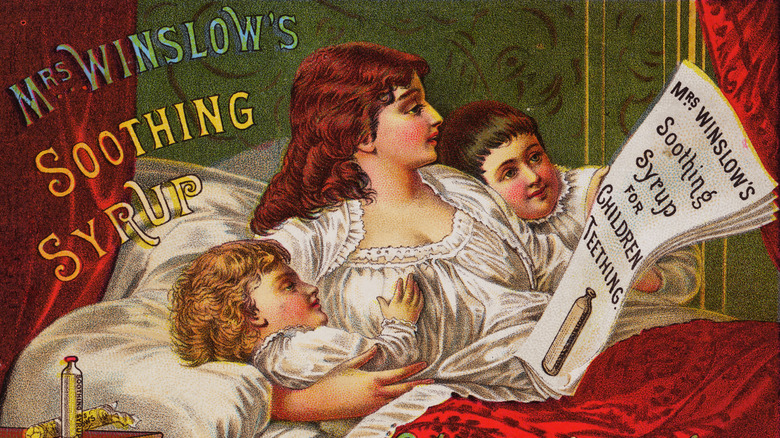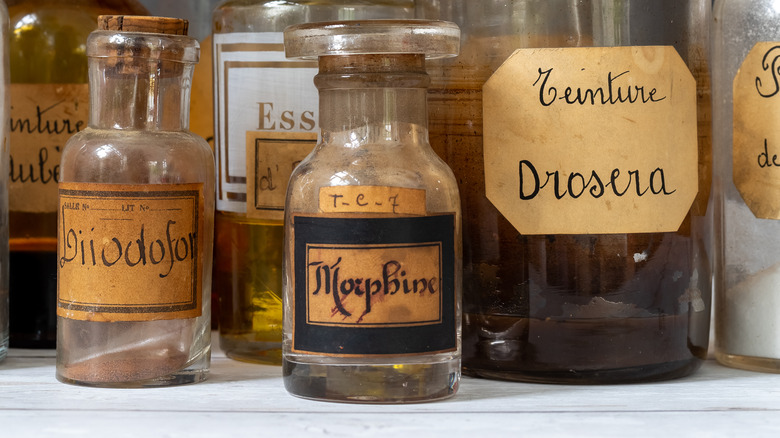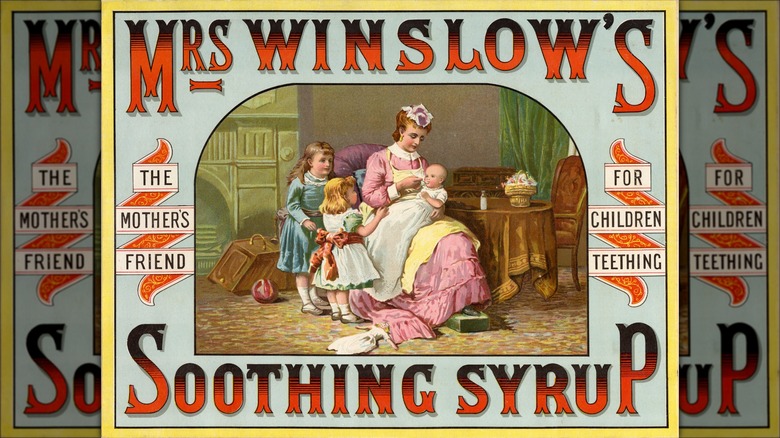The Victorian Syrup That Accidentally Killed Children
In the 1800s, a nurse named Charlotte Winslow developed a liquid, which, she claimed, would soothe agitated infants, particularly those that were teething. The product — which was billed as "Mrs. Winslow's Soothing Syrup" — went on sale in 1849 thanks to the efforts of her son-in-law, Jeremiah Curtis, and Benjamin A. Perkins, both pharmacists. It quickly found a market among tired mothers, nannies, and other caregivers who struggled to get their teething infants to relax and go to sleep.
"Mrs. Winslow's Soothing Syrup" was marketed widely across the United States and in the United Kingdom. Museum of Healthcare at Kingston claims that the liquid was widely used for many decades, from when it first hit the market in the middle of the 19th century, right up until the early years of the 20th, when its marketing material read (via the Smithsonian): "Has been used for over FIFTY YEARS by MILLIONS of MOTHERS for their CHILDREN WHILE TEETHING, with PERFECT SUCCESS. It SOOTHES the CHILD, SOFTENS the GUMS, ALLAYS all PAIN, CURES WIND COLIC, and is the best remedy for DIARRHOEA. Sold by Druggists in every part of the world. Be sure and ask for 'Mrs. WINSLOW'S SOOTHING SYRUP[.]'"
But horrifyingly, the concoction was deadly to small children, a fact that remained covered up for many years, by which time the product is believed to have caused thousands of infant deaths. After the truth was revealed, Mrs. Winslow's recipe was given another name: "The Baby Killer."
The deadly ingredients in The Baby Killer
Back in the day when "Mrs. Winslow's Soothing Syrup" was on sale, there was no law stipulating that the producers of over-the-counter medicines print the contents of their concoctions on the packaging. In fact, the secrecy of their ingredients was held by many consumers to be an indication of a product's special properties, suggesting that it had an edge over its competitors.
So what did Mrs. Winslow put into her secret syrup recipe that proved to be so effective in calming small children and babies? A combination of alcohol and opium — specifically morphine, and several other chemicals. As shocking as these ingredients seem to us today, the fact is that many such medicines existed at the time, with the general public overall unaware of the long-term health risks of opium or its addictive properties. Nevertheless, the levels of morphine in "Mrs. Winslow's Soothing Syrup" in their prescribed doses made the product one of the most deadly on the market to babies and small children.
Changes to packaging meant changes to the recipe
In 1905, Collier's ran an expose titled "THE GREAT AMERICAN FRAUD" that dug into the opaque world of patent medicines, which by then had created a country-wide opium epidemic, just as the prevalence of opioid painkillers has today (via the Museum of Quackery). The article, which reflected growing concern from medical experts, was a bombshell, waking the American people up to the widespread destruction such products had caused to their health and the many millions of potential deaths they had caused.
The outrage caused by the expose led to the creation of the Pure Food and Drug Act of 1906, which finally made manufacturers responsible for communicating potentially dangerous ingredients in their medicines, and ensuring that the drugs included — for they continued to be used — were of medical standard. Despite the new law, the makers of "Mrs. Wimslow's Soothing Syrup" were able to continue trading by removing morphine from the recipe entirely. At that point, though, the deadly damage had been done, and the horrifying truth of "The Baby Killer" — which was advertised as "the mother's friend" — had been revealed. By the 1930s the product was nothing but a grim memory of a time when patent medicines were widely available with zero oversight.


